An online project under the direction of the CAPE ANN MUSEUM
inv. 46
New York Harbor
c. 1855 Oil on canvas 36 x 60 1/4 in. (91.4 x 153 cm) Signed and dated lower right: Fitz H Lane. / 185[...]
|
Supplementary Images
Additional material
Explore catalog entries by keywords view all keywords »
Historical Materials
Below is historical information related to the Lane work above. To see complete information on a subject on the Historical Materials page, click on the subject name (in bold and underlined).
Newsprint
From bound volume owned by publisher Francis Procter
Collection of Fred and Stephanie Buck
“LANE’S CHEF-D’OEUVRE. – Our talented townsman, Fitz H. Lane, Esq., one of the finest marine painters in this country, has now on free exhibition at the room of the Marine Insurance Company, a picture of New York harbor, with all the bewildering variety of ship-craft for which that bay is noted. The beholder seems standing upon the water; at a distance is a faint outline of the city, with that object, which like the State House in Boston, is always the most conspicuous in a view, however faint, of New York city—Trinity Church. A warm glow of sunshine rests upon the whole picture. Here is the stately clipper ship; the graceful steamer; the clumsy Indiaman; the rakish pilot boat; the puffing tug-boat and the uncouth lighter, and one waits in expectancy for the ferry boat to rush across the quiet scene. The shadows of the ships’ tall masts seem trembling down in the bosom of the water: every rope, block and sail, is arranged with nautical skill and exactness: in fine, the picture is worthy of Lane’s genius and his inimitable pencil. If it is not already purchased, it should be placed in the Merchant’s Exchange of New York, by the merchant princes of that city.”
Oil on canvas
36 x 60 1/4 in.
Museum of Fine Arts, Boston, Gift of Maxim Karolik for the M. and M. Karolik Collection of American Paintings, 1815–65 (48.446)
Detail of Whitehall boat.
Filed under: New York Harbor » // Whitehall Boat »
New York City's large population and busy harbor meant that in the mid-nineteenth century it served as the largest domestic market for American products as well as the supplier for most of the export goods for the United States. In 1850 its population was larger than that of Philadelphia and nearly five times as large as that of Boston. (1)
The large broad harbor of New York, easily accessible from the Atlantic, encouraged foreign trade. But it also provided access to western New England and upstate New York via the Hudson River and southern New England via Long Island Sound. Between 1841-1850 New York handled an average of 60% of the U.S. imports and 30.5% of exports. (2) Piers, wharves, and docks ringed the south end of Manhattan: in 1850 over 60 on the East River served the foreign trade, while the 50 or more on the Hudson were filled with steamships and river boats to go up the river. (3) New York kept its position as the largest American seaport through its role as a market, a financial center, and its important position in the trade routes, but another advantage was its low wharfage rates. Although the wharves were notorious for their poor condition, in 1852 the cost to unload 1700 bales of cotton over two days in Boston or Baltimore was $68 while at a Hudson River pier it cost a mere $4.88. (4)
References:
See also: Robert Albion, The Rise of New York Port [1850-1871], David & Charles, 1971.
(1) Edward Spann, The New Metropolis: New York City 1840-1857, Columbia University Press, 1981, p.430.
(2) Spann p.436.
(3) Edwin G. Burrows and Mike Wallace, Gotham: A History of New York City to 1898, Oxford University Press, 1999, p.652.
(4) Burrows & Wallace, p.654
Color lithograph
Published by N. Currier, New York
LoC Catalog Number 90715981
Bird's-eye view of New York City with Battery Park in the foreground and Brooklyn Heights in the lower right corner.
Also filed under: Castle Garden »
Photograph
Johnson, H. and Lightfoot, F.S.: Maritime New York in Nineteenth-Century Photographs, Dover Publications, Inc., New York
The New York pilot boats would sail out to meet large incoming ships, flying the blue and white flag. The pilot would board the large ship and guide her into harbor. On outgoing trips the pilot boat would pick up the pilot after the ship in his charge had cleared the harbor.
Also filed under: Schooner (Pilot) »
15 1/2 x 13 1/2 in
New York Public Library
Barcode number 33333159142682
Also filed under: Tow Boat / Tug Boat »
Photograph
Johnson, H. and Lightfoot, F.S.: Maritime New York in Nineteenth-Century Photographs, Dover Publications, Inc., New York
Also filed under: Packet Shipping »
Survey of the Coast of the United States, New York Harbors, Washington, D.C.
Collection of Erik Ronnberg.
Also filed under: Maps »
Lithograph
Published by N. Currier, New York
Library of Congress Catalog Number 2002698126
Also filed under: Currier (& Ives) – New York »
Newspaper
Gloucester Telegraph, p. 2, col. 1
American Antiquarian Society
"F.H. Lane, Esq., with characteristic generosity has loaned some of his grand paintings to increase the interest of the occasion. A look at the Stiff Breeze in New York Harbor, one of the finest of his fine productions, and enough in itself to secure him enduring fame, is worth many times over the price of the admittance fee. A sailor could scarecely gaze upon the brig going in stays, without every moment expecting to hear the command given to 'let go and haul.'"
Also filed under: Gloucester Community / Participation / Other projects » // Newspaper / Journal Articles »
Telegraph and News
p. 2 column 2
"Fine Picture– Mr. F. H. Lane has placed in the Marine Insurance Office a very handsome picture of New York Harbor, which he has just completed. All sorts of vessels are represented in the foreground, with every particular rope in its proper place while in the background is the city with its forests of masts around the wharves it is truly a fine specimen of his artistic skill."
Also filed under: Gloucester, Mass. – Marine Insurance Company » // Newspaper / Journal Articles »
Oil on canvas
10 1/2 x 16 3/8 in.
Inscribed to Jenny Lind
New-York Historical Society, Purchase, Thomas Jefferson Bryan Fund (1977.76)
Also filed under: Castle Garden »
Lithograph
Published by N. Currier, New York
Also filed under: Currier (& Ives) – New York » // Tow Boat / Tug Boat » // Trinity Church »
Hand-colored lithograph
35 x 25 cm. on sheet 48 x 30 cm.
Published by Magnus & Co.
New York Public Library
Covers Manhattan up to 34th Street on the west side and 51st Street on the east side. Includes views of New York City and Harbor, and Trinity Church above the upper neat line. Also includes list of churches, hotels, and places of amusement.
Also filed under: Castle Garden » // Maps »
Oil on canvas
36 x 60 1/4 in.
Museum of Fine Arts, Boston, Gift of Maxim Karolik for the M. and M. Karolik Collection of American Paintings, 1815–65 (48.446)
Detail of Whitehall boat.
Also filed under: Whitehall Boat »
Lithograph
Published by N. Currier, New York
Library of Congress Catalog Number 2002698127
Also filed under: Currier (& Ives) – New York »
New York's Trinity Church, an Episcopal church located on Broadway at the head of Wall Street, is a visible landmark on the city's skyline. After two others on the site, the grand new one was designed by Richard Upjohn and begun in 1839 and completed in 1846. Its 281-foot Neo-Gothic spire and gilded cross was the highest point in New York for most of the nineteenth century.
Lithograph
Published by N. Currier, New York
Also filed under: Currier (& Ives) – New York » // New York Harbor » // Tow Boat / Tug Boat »
Schooners in Lane’s time were, with few exceptions, two-masted vessels carrying a fore-and-aft rig having one or two jibs, a fore staysail, gaff-rigged fore- and main sails, and often fore- and main topsails. One variant was the topsail schooner, which set a square topsail on the fore topmast. The hulls of both types were basically similar, their rigs having been chosen for sailing close to the wind. This was an advantage in the coastal trade, where entering confined ports required sailing into the wind and frequent tacking. The square topsail proved useful on longer coastwise voyages, the topsail providing a steadier motion in offshore swells, reducing wear and tear on canvas from the slatting of the fore-and-aft sails. (1)
Schooners of the types portrayed by Lane varied in size from 70 to 100 feet on deck. Their weight was never determined, and the term “tonnage” was a figure derived from a formula which assigned an approximation of hull volume for purposes of imposing duties (port taxes) on cargoes and other official levies. (2)
Crews of smaller schooners numbered three or four men. Larger schooners might carry four to six if a lengthy voyage was planned. The relative simplicity of the rig made sail handling much easier than on a square-rigged vessel. Schooner captains often owned shares in their vessels, but most schooners were majority-owned by land-based firms or by individuals who had the time and business connections to manage the tasks of acquiring and distributing the goods to be carried. (3)
Many schooners were informally “classified” by the nature of their work or the cargoes they carried, the terminology coined by their owners, agents, and crews—even sometimes by casual bystanders. In Lane’s lifetime, the following terms were commonly used for the schooner types he portrayed:
Coasting schooners: This is the most general term, applied to any merchant schooner carrying cargo from one coastal port to another along the United States coast (see Bar Island and Mt. Desert Mountains from Somes Settlement, 1850 (inv. 401), right foreground). (4)
Packet schooners: Like packet sloops, these vessels carried passengers and various higher-value goods to and from specific ports on regular schedules. They were generally better-maintained and finished than schooners carrying bulk cargoes (see The Old Fort and Ten Pound Island, Gloucester, 1850s (inv. 30), center; and Gloucester Inner Harbor, 1850 (inv. 240), stern view). (5)
Lumber schooners: Built for the most common specialized trade of Lane’s time, they were fitted with bow ports for loading lumber in their holds (see View of Southwest Harbor, Maine: Entrance to Somes Sound, 1852 (inv. 260)) and carried large deck loads as well (Stage Rocks and the Western Shore of Gloucester Outer Harbor, 1857 (inv. 8), right). Lumber schooners intended for long coastal trips were often rigged with square topsails on their fore masts (see Becalmed Off Halfway Rock, 1860 (inv. 344), left; Maverick House, 1835 (not published); and Lumber Schooner in a Gale, 1863 (inv. 552)). (6)
Schooners in other specialized trades. Some coasting schooners built for carrying varied cargoes would be used for, or converted to, special trades. This was true in the stone trade where stone schooners (like stone sloops) would be adapted for carrying stone from quarries to a coastal destination. A Lane depiction of a stone schooner is yet to be found. Marsh hay was a priority cargo for gundalows operating around salt marshes, and it is likely that some coasting schooners made a specialty of transporting this necessity for horses to urban ports which relied heavily on horses for transportation needs. Lane depicted at least two examples of hay schooners (see Gloucester Harbor, 1850s (inv. 391), left; and Coasting Schooner off Boon Island, c.1850 (inv. 564)), their decks neatly piled high with bales of hay, well secured with rope and tarpaulins.
– Erik Ronnberg
References:
1. Howard I. Chapelle, The History of American Sailing Ships (New York: W.W. Norton & Co., 1935), 258. While three-masted schooners were in use in Lane’s time, none have appeared in his surviving work; and Charles S. Morgan, “New England Coasting Schooners”, The American Neptune 23, no. 1 (DATE): 5–9, from an article which deals mostly with later and larger schooner types.
2. John Lyman, “Register Tonnage and its Measurement”, The American Neptune V, nos. 3–4 (DATE). American tonnage laws in force in Lane’s lifetime are discussed in no. 3, pp. 226–27 and no. 4, p. 322.
3. Ship Registers of the District of Gloucester, Massachusetts, 1789–1875 (Salem, MA: The Essex Institute, 1944). Vessels whose shipping or fishing voyages included visits to foreign ports were required to register with the Federal Customs agent at their home port. While the vessel’s trade or work was unrecorded, their owners and master were listed, in addition to registry dimensions and place where built. Records kept by the National Archives can be consulted for information on specific voyages and ports visited.
4. Howard I. Chapelle, The National Watercraft Collection (Washington, DC: Smithsonian Institution, 1960), 40, 42–43.
5. Ibid., 42–43, 73.
6. Ibid., 74–76.
A topsail schooner has no tops at her foremast, and is fore-and-aft rigged at her mainmast. She differs from an hermaphrodite brig in that she is not properly square-rigged at her foremast, having no top, and carrying a fore-and-aft foresail instead of a square foresail and a spencer.
Wood rails, metal rollers, chain; wood cradle. Scale: ½" = 1' (1:24)
Original diorama components made, 1892; replacements made, 1993.
Cape Ann Museum, from Gloucester Chamber of Commerce, 1925 (2014.071)
A schooner is shown hauled out on a cradle which travels over racks of rollers on a wood and metal track.
Also filed under: Burnham Brothers Marine Railway » // Marine Railways »
Glass plate negative
Collection of Erik Ronnberg
Also filed under: Lobstering »
Details about Maine's lumber trade in 1855, see pp. 250–52
Also filed under: Castine » // Lumber Industry »
The term "ship," as used by nineteenth-century merchants and seamen, referred to a large three-masted sailing vessel which was square-rigged on all three masts. (1) In that same period, sailing warships of the largest classes were also called ships, or more formally, ships of the line, their size qualifying them to engage the enemy in a line of battle. (2) In the second half of the nineteenth century, as sailing vessels were replaced by engine-powered vessels, the term ship was applied to any large vessel, regardless of propulsion or use. (3)
Ships were often further defined by their specialized uses or modifications, clipper ships and packet ships being the most noted examples. Built for speed, clipper ships were employed in carrying high-value or perishable goods over long distances. (4) Lane painted formal portraits of clipper ships for their owners, as well as generic examples for his port paintings. (5)
Packet ships were designed for carrying capacity which required some sacrifice in speed while still being able to make scheduled passages within a reasonable time frame between regular destinations. In the packet trade with European ports, mail, passengers, and bulk cargos such as cotton, textiles, and farm produce made the eastward passages. Mail, passengers (usually in much larger numbers), and finished wares were the usual cargos for return trips. (6) Lane depicted these vessels in portraits for their owners, and in his port scenes of Boston and New York Harbors.
Ships in specific trades were often identified by their cargos: salt ships which brought salt to Gloucester for curing dried fish; tea clippers in the China Trade; coffee ships in the West Indies and South American trades, and cotton ships bringing cotton to mills in New England or to European ports. Some trades were identified by the special destination of a ship’s regular voyages; hence Gloucester vessels in the trade with Surinam were identified as Surinam ships (or barks, or brigs, depending on their rigs). In Lane’s Gloucester Harbor scenes, there are likely (though not identifiable) examples of Surinam ships, but only the ship "California" in his depiction of the Burnham marine railway in Gloucester (see Three Master on the Gloucester Railways, 1857 (inv. 29)) is so identified. (7)
– Erik Ronnberg
References:
1. R[ichard)] H[enry] Dana, Jr., The Seaman’s Friend, 13th ed. (Boston: Thomas Groom & Co., 1873), p. 121 and Plate IV with captions.
2. A Naval Encyclopaedia (Philadelphia: L. R. Hamersly & Co., 1884), 739, 741.
3. M.H. Parry, et al., Aak to Zumbra: A Dictionary of the World’s Watercraft (Newport News, VA: The Mariners’ Museum, 2000), 536.
4. Howard I. Chapelle, The History of American Sailing Ships (New York: W.W. Norton & Co., 1935), 281–87.
5. Ibid.
6. Howard I. Chapelle, The National Watercraft Collection (Washington, DC: Smithsonian Institution, 1960), 26–30.
7. Alfred Mansfield Brooks, Gloucester Recollected: A Familiar History (Gloucester, MA: Peter Smith, 1974), 67–69.
Photograph
From American Clipper Ships 1833–1858, by Octavius T. Howe and Frederick C. Matthews, vol. 1 (Salem, MA: Marine Research Society, 1926).
Photo caption reads: "'Golden State' 1363 tons, built at New York, in 1852. From a photograph showing her in dock at Quebec in 1884."
Also filed under: "Golden State" (Clipper Ship) »
Oil on canvas
24 x 35 in.
Peabody Essex Museum, Salem, Mass.
Walters' painting depicts the "Nonantum" homeward bound for Boston from Liverpool in 1842. The paddle-steamer is one of the four Clyde-built Britannia-class vessels, of which one is visible crossing in the opposite direction.
View related Fitz Henry Lane catalog entries (2) »
Also filed under: Packet Shipping » // Walters, Samuel »
Sloops are one-masted sailing vessels which, in American examples, set fore-and-aft sails but usually no square sails. Thus, staysails, or jibs, are set from the fore stay(s) and a quadrilateral mainsail is set from the mast and spread by a gaff and a boom. The larger sloops would often set a triangular topsail over the main sail. (1)
The sloops depicted by Lane were used in various coastal trades, each with its own requirements, which dictated the sizes and details of their hulls and rigs. Most elegant were the packet sloops, which transported passengers, mail, and higher value goods between specific ports on regular schedules. They usually measured between sixty and seventy-five feet on deck, as dictated by anticipated shipping volume. Finely finished, they usually had stern galleries—a row of windows across the transom with ornamental moldings—and varied color schemes. Examples of packet sloops are in Gloucester Harbor from Rocky Neck, 1844 (inv. 14) (center, middle ground) and Study of Ships, 1851 (inv. 141) (foreground), both of which probably made trips between Gloucester and Boston, or Gloucester and Newburyport. (2)
Another specialized sloop of similar size was the stone sloop, used to ship granite blocks from stone-loading piers around Cape Ann to other ports. They were similar in rig to packet sloops, but of heavier construction with greater hold capacity and absence of decoration. Their stout appearance was augmented by simple color schemes, or even tarred topsides, reflecting the wear and strain imposed by their heavy cargos. Lane depicted these vessels in his painting of Fresh Water Cove from Dolliver's Neck, Gloucester, Early 1850s (inv. 45), with a sloop (at left) preparing to load at wharf-side, and another (at right) sailing out with a cargo. (3)
Sloops of the more work-a-day sort are the most commonly seen examples in Lane’s paintings, most of them appearing in his views of Boston Harbor. Usually deep-loaded and looking weather-worn, they contrast sharply with the packet- and clipper ships which dominate the scene. Sloops of this type are rarely seen in Lane’s paintings of Gloucester Harbor and the Maine coast, although they were certainly needed for short-distance transportation (see Bear Island, Northeast Harbor, 1855 (inv. 24), View of Camden Mountains from Penobscot Bay, c.1852 (inv. 207), Sunrise on the Maine Coast, Mount Desert Island, 1856 (inv. 295)). For coastal Maine, lack of railroads for heavier freight and greater distances between ports made the use of schooners with larger carrying capacity a greater necessity. (4)
In Lane’s views of New York Harbor, a regional sloop variant, the Hudson River Sloop, appears in New York Harbor, c.1855 (inv. 46) (bow view, left) and A Calm Sea, c.1860 (inv. 6) (stern view, right). This type had become prominent in the Hudson River packet trade between New York City, Albany, and beyond to points north and west as far as the eastern terminus of the Erie Canal. Large vessels for their rigs, they were well-finished and well-kept, reflecting pride of ownership and rivalry among their owners and crews. (5)
– Erik Ronnberg
References:
1. A Naval Encyclopaedia (Philadelphia: L.R. Hamersly & Co., 1884. Reprint: Detroit, MI: Gale Research Company, 1971), 59. See first definition of "sloop" and definition of "sloop-rigged."
2. Robert Greenhalgh Albion, William A. Baker, and Benjamin Woods Labaree, New England and the Sea (Mystic, CT: Mystic Seaport Museum, 1972; reprinted in 1994), 127–28.
3. Howard I. Chapelle, The History of American Sailing Ships (New York: W.W. Norton & Co., 1935), 300–02.
4. Ibid., 300.
5. Ibid., 298–300.
A Naval Encyclopaedia:
Dictionary of nautical words and phrases
Special Articles on Naval Art and Science
Philadelphia: L.R. Hamersly & Co.
'Mudian, "Mugian, or Bermudian. A boat special to the Bermuda islands, usually decked, with the exception of a hatch; from 2 to 20 tons burden; it is short, of good beam, and great draft of water abaft, the stem and keel forming a curved line. It carries an immense quantity of ballast. Besides a long main- and short jib-boom, it has a long, taperking, raking mast, stepped just over the forefoot, generally unsupported by shrouds or stays; on it a jib-headed mainsail is hoisted to a height of twice, and sometimes three times, the length of the keel. This sail is triangular, stretched at its foot by a long boom. The only other sail is a small foresail or jib. They claim to be the fastest craft in the world for working to windward in smooth water, it being recorded of one that she made five miles dead to windward in the hour during a race; and though they may be laid over until they fill with water, they will not capsize.
St. George's Historical Society
Detail of painting of St. George's Harbour, Bermuda, during US Civil War, with a Confederate blockade runner anchored in the foreground.
Also filed under: Puerto Rico »
Wood, metal, cordage, cloth, paint.
Scale: ¼ in. = 1ft. (1:48)
Cape Ann Museum. Gift of Roland and Martta Blanchet (1997.17.3)
Although built in 1890 and larger than the stone sloops of Lane’s time, the "Albert Baldwin’s" hull form, rig, and loading boom are very similar to those of the 1840s and 1850s.
Also filed under: Granite Quarrying / Shipping » // Ship Models »
"Engine-powered vessel" is a collective term used by nautical historians to include all vessel types using engine power of any type for propulsion, whether assisted by sails, oars, or other motive power. In Lane's time, steam reciprocating engines fueled by wood or coal were the only practical source of this power for ships using paddle-wheels or screw propellers to convert heat energy into motion.
For most of the nineteenth century, steamships had sails for auxiliary power; indeed the earliest examples relied principally on sails, using engine power in calm weather to shorten the voyage time or keep to a schedule. As engines became more efficient, powerful, and reliable, sail plans were reduced, to be used only to steady a vessel's motion in a seaway (for the sake of seasick passengers), or to maintain headway if the engine broke down. Only harbor craft, ferry boats, and coastwise passenger steamers relied solely on engine power.
Among Lane's depictions of steamships, the auxiliary steam packet Auxiliary Steam Packet Ship Massachusetts (inv. 442) is a good example of primary reliance on sails, while the steam demi-bark The "Britannia" Entering Boston Harbor, 1848 (inv. 49) and the Cunard Liner "Britannia", 1842 (inv. 259) have relegated sails to secondary (or simply emergency) motive power.
– Erik Ronnberg
Castine Historical Society Collections (2015.03)
Also filed under: Historic Photographs » // Steamers »
Published by James French, Boston
Volume 1848-49
Boston Public Library
Call number 39999059856813
See p. 30 of directory.
Also filed under: "Britannia" (Cunard Steamship) » // "Caledonia" (Cunard Steamship) » // Trade Routes and Statistics »
Cartoon
9 1/4 x 13 3/4 in (23.495 x 34.925 cm)
Peabody Essex Museum, Salem, Mass.
Jonny and a Yankee:
Jonny: "Ho my Hi! 'ow she goes!! it his'nt fair I ham sure t'aint!!! She must 'av an engine hunder the keel..."
Yankee: "Where are your yachts now, Jonny? s-a-y- Do you think your wash tubs can come up to a real Yankee Clipper? Sorry for you, Jonny, but it can't be helped... A Yankee Ship a Yankee Crew, you know Jonny."
Also filed under: "America" (Schooner Yacht) »
Lithograph
Library of Congress Catalog Number 2002706878
Design of side wheel steamer showing wheel mechanism, side view and cross-section in ten figures. This design proved a failure in the few vessels that employed it. The paddle wheel enclosures filled with water, causing resistance which greatly impaired efficiency and increased fuel consumption.
– Erik Ronnberg
Oil on canvas
Maine Maritime Museum
Also filed under: Castine »
Steamer schedules for 1855, including the schedule for the steamer, "T. F. Secor" which served Castine, see pp. 234–35.
Also filed under: "T. F. Secor" (Steamboat) » // Castine » // Publications » // Steamers »
Tug boat is a general term for vessels of a variety of sizes designed to tow and push large vessels into and out of harbor berths, through confined waterways, and undertake towing and salvage work in deep water. Tugs designed for towing large vessels over long ocean routes are called tow boats, and are larger and more powerful than their harbor-based counterparts.
Throughout the nineteenth century, tug boats were powered with a variety of steam reciprocating engines, the "cross-head" and "walking beam" types being suitable for the early vessels driven by paddle wheels and used in protected harbors. The introduction of the screw propeller and more compact compound engines, made tug boats less susceptible to damage when used in open ocean, leading to the development of tow boats. (1)
New York Harbor was the first American seaport to make extensive use of harbor tugs, due to the size of New York Bay and anchorages therein. A multitude of wharves along the shorelines of Manhattan, Brooklyn, and the New Jersey side (not to mention river traffic from points north on the Hudson River and barge traffic from the Delaware and Hudson Canal) all contributed to a demand for their services. (2)
Boston Harbor, by contrast, was much smaller, with its wharves confined to a compact waterfront. Here, it was easier to move a vessel by warping it from pierhead to pierhead than to use a tug boat for such short-distance work. Even with expansion of the waterfront in the late nineteenth century, Boston had a far smaller harbor tug fleet than New York. (3)
What Boston did need were a few large tow boats for coastwise work. Most large shipyards north of Cape Cod needed tow boat services for sending the ships they built to southern ports for fitting-out. New York had a particular need for this service so vessels built in other yards (including Boston's) could be towed to it for completion (including sails, boats, cabin finish work, marine hardware, and sometimes even masts and rigging). Boston's proximity to New England shipyards made it the logical place to operate a towing service, and Robert Bennet Forbes was one of the first to act on this opportunity. An iron-hull, screw-propelled tow boat was built to his specifications in 1846 for Boston underwriters, who named it in his honor. (4)
– Erik Ronnberg
References:
1. Steven Lang and Peter H. Spectre, On the Hawser: A Tugboat Album (Camden, ME: Down East Books, 1980), xi–xii, 2–5.
2. Harry Johnson and Frederick S. Lightfoot, Maritime New York in Nineteenth-Century Photographs (New York: Dover Publications, Inc., 1980), ix–xii, 3, 7–8.
3. W.H. Bunting, Portrait of a Port: Boston, 1852–1914 (Boston: Belknap Press, 1977), 150.
4. Forbes, Robert Bennet, Personal Reminiscences (Boston: Little, Brown, & Co., 1892), listing of iron steam tug R.B. Forbes in appended "List of Vessels."
15 1/2 x 13 1/2 in
New York Public Library
Barcode number 33333159142682
Also filed under: New York Harbor »
Lithograph
Published by N. Currier, New York
Also filed under: Currier (& Ives) – New York » // New York Harbor » // Trinity Church »
The Whitehall Boat, like the yawl boat, is an early nineteenth-century refinement of an earlier ship's boat type—very likely the gigs of warships. Builders of the earliest examples are believed to have been former navy shipyard employees whose knowledge was put to use building similar boats in their shops on Whitehall Street in lower Manhattan. Recognized as a distinct small boat type in the 1830s, by mid-nineteenth century the Whitehall Boat was in use in most American seaports. (1)
Lane depicted Whitehall Boats in a number of his paintings of major ports, including New York Harbor, c.1855 (inv. 46) (right center foreground), which shows a large example, rowed by four men witha single passenger in the stern, illustrating one of its chief uses as a water taxi. These craft were also used by ship chandlers to deliver ship supplies, and most notoriously by "crimps" who used them to deliver drunken seamen to outbound ships needing crews. Not intended for use in open sea, their light yet strong construction, fine lines, and maneuverability made them ideal for in-harbor work. (2)
Other Whitehall boats appear in the foregrounds of Boston and other unidentified major port scenes (see New England Harbor at Sunrise, c.1850 (inv. 27), Brig "Antelope" in Boston Harbor, 1863 (inv. 43), The "Britannia" Entering Boston Harbor, 1848 (inv. 49), Boston Harbor, Sunset, 1850–55 (inv. 242), The "Constitution" in Boston Harbor, c.1848–49 (inv. 243), and Clipper Ship "Southern Cross" in Boston Harbor, 1851 (inv. 253)).
References:
1. Howard I. Chapelle, American Small Sailing Craft (New York: W.W. Norton & Co., 1951), 195–96.
2. Ibid., 196–99.
Oil on canvas
36 x 60 1/4 in.
Museum of Fine Arts, Boston, Gift of Maxim Karolik for the M. and M. Karolik Collection of American Paintings, 1815–65 (48.446)
Detail of Whitehall boat.
Also filed under: New York Harbor »
The ensign of the United States refers to the flag of the United States when used as a maritime flag to indentify nationality. As required on entering port, a vessel would fly her own ensign at the stern, but a conventional token of respect to the host country would be to fly the flag of the host country (the United States in Boston Harbor, for example) at the foremast. See The "Britannia" Entering Boston Harbor, 1848 (inv. 49) for an example of a ship doing this. The American ensign often had the stars in the canton arranged in a circle with one large star in the center; an alternative on merchant ensigns was star-shaped constellation. In times of distress a ship would fly the ensign upside down, as can be seen in Wreck of the Roma, 1846 (inv. 250).
The use of flags on vessels is different from the use of flags on land. The importance and history of the flagpole in Fresh Water Cove in Gloucester is still being studied.
The modern meaning of the flag was forged in December 1860, when Major Robert Anderson moved the U.S. garrison from Fort Moultrie to Fort Sumter in Charleston Harbor. Adam Goodheart argues this was the opening move of the American Civil War, and the flag was used throughout northern states to symbolize American nationalism and rejection of secessionism.
Before that day, the flag had served mostly as a military ensign or a convenient marking of American territory, flown from forts, embassies, and ships, and displayed on special occasions like American Independence day. But in the weeks after Major Anderson's surprising stand, it became something different. Suddenly the Stars and Stripes flew—as it does today, and especially as it did after the September 11 attacks in 2001—from houses, from storefronts, from churches; above the village greens and college quads. For the first time American flags were mass-produced rather than individually stitched and even so, manufacturers could not keep up with demand. As the long winter of 1861 turned into spring, that old flag meant something new. The abstraction of the Union cause was transfigured into a physical thing: strips of cloth that millions of people would fight for, and many thousands die for.
– Adam Goodheart, Prologue of 1861: The Civil War Awakening (2011).
Stereograph card
Cape Ann Museum Library & Archive
A view of a Cove on the western side of Gloucester Harbor, with the landing at Brookbank. Houses are seen in the woods back. A boat with two men is in the foreground.
Also filed under: Brookbank » // Fresh Water Cove » // Historic Photographs »
Courtesy American Antiquarian Society, Worcester, Mass. (CL.F9116.011.1854 CL.F9116.011.1854)
Also filed under: Oak Hall »
Courtesy American Antiquarian Society, Worcester, Mass. (CL.F9116.011.1854)
Also filed under: Oak Hall »
Packet shipping was conducted by vessels of many types in many regions over the last four centuries, but the packets depicted by Lane were the products of nineteenth-century mercantilism and the Industrial Revolution. The packets sailing out of Boston and New York for European ports were large vessels, invariably ship-rigged, and if not as sharp-ended as clipper ships, had sufficiently fine hull forms to make fast, if not record, passages.
A packet ship's highest priority was delivery of mail on a regular schedule. Passengers and high-value trade goods occupied the considerable remaining hold space. This was particularly true of west-bound passages, which brought fine European wares and throngs of immigrants to America. East-bound passages brought professionals, students, travelers, and high-value raw and semi-finished materials to European ports, mainly Britain and France, and to a lesser extent, the Netherlands and Germany.
East-bound cargos were dominated by southern products - baled cotton, rice, tobacco, and naval stores. These were delivered to New York and other northern ports by coastal packets (mainly brigs and small ships) for transatlantic shipment. Northern products included flaxseed, iron ore, fruit, wool, hides, and flour. Delivery times were on average well within 30 days, giving credence to the packet lines' promise of scheduled delivery.
West-bound passages, which meant sailing against the wind, took longer—34 to 40 days on average, depending on the port of departure. Cargos and passengers were a far more varied lot with little of the consistency of east-bound counterparts.
Lane's paintings depict Boston and New York packet ships in the peak years of their employment. The Civil War, coupled with the development of reliable steam engines for marine propulsion, posed challenges the sailing ship could not overcome. Coastal packet lines went quickly, the transatlantic lines lasting into the 1870s.
– Erik Ronnberg
Reference:
Robert G. Albion, Square-Riggers on Schedule (Princeton, NJ: Princeton University Press, 1938).
Photograph
Johnson, H. and Lightfoot, F.S.: Maritime New York in Nineteenth-Century Photographs, Dover Publications, Inc., New York
Also filed under: New York Harbor »
Oil on canvas
24 x 35 in.
Peabody Essex Museum, Salem, Mass.
Walters' painting depicts the "Nonantum" homeward bound for Boston from Liverpool in 1842. The paddle-steamer is one of the four Clyde-built Britannia-class vessels, of which one is visible crossing in the opposite direction.
View related Fitz Henry Lane catalog entries (2) »
Also filed under: Ship (Full-Rigged) » // Walters, Samuel »
Vessel ornamentation assumed two forms: carvings and color schemes. Carvings, or "ship carvings," as they are called by maritime scholars, are usually crafted in wood and painted or gilt. Many vessels were too small or their owners too frugal to permit carved embellishments, in which cases the enhancement of the vessel's color scheme was a practical alternative. This can be seen in many of the coastal vessels along the new England coast. Pinkies and Chebacco boats had handsome color schemes using only black and green with white sheer lines and limited use of red and yellow. Other combinations of inexpensive pigments were used to improve the simple looks of sloops and schooners in the packet trade, while small pleasure craft and pilot schooners enhanced their appearance in similar ways. Clipper ship owners, finding their vessels' appearance impressive without adding color, settled for unrelieved black hulls. Naval vessels as well preserved their formidable looks with black, relieved only with a white belt in way of the gunports.
The more elaborate ship carvings can be classified in the following categories:
Billetheads: mounted on the bow, at the end of a simple gammon knee, or on the forward end of an elaborate stem-head, they can be scrolls of less or greater intricacy, or sometimes the heads of animals, eagles being the most common. Examples of a sea serpent's head, a pointing hand, and other animal heads have been found. (See Brig "Cadet" in Gloucester Harbor, late 1840s (inv. 13); Brig "Antelope" in Boston Harbor, 1863 (inv. 43); and Brig Off the Maine Coast, 1851 (inv. 241))
Figureheads: mounted on bows of larger vessels, often with elaborate stem joinerwork (trailboards and headboards with associated knees and rails). Usually these were full-length figures representing the ship's owner, a famous citizen, a mythological person or animal, or an eagle. (See Portrait of the "National Eagle", 1853 (inv. 35) (eagle); New York Harbor, c.1855 (inv. 46); The "Britannia" Entering Boston Harbor, 1848 (inv. 49) (female figures); The Ships "Winged Arrow" and "Southern Cross" in Boston Harbor, 1853 (inv. 54) (dragon and eagle); "Starlight" in Harbor, c.1855 (inv. 249) (dragon); and Steam demi bark Antelope, 615 tons, c.1855 (inv. 375) (antelope))
Trailboards: carved vines or scrollwork abaft the figurehead which trail aft along the stem head in a graceful descending arc, terminating at the hawse pipes. They are usually gilt and frequently ornamented with carved rosettes and other devices. (See Brig "Cadet" in Gloucester Harbor, late 1840s (inv. 13); Portrait of the "National Eagle", 1853 (inv. 35); Brig "Antelope" in Boston Harbor, 1863 (inv. 43); New York Harbor, c.1855 (inv. 46); and The Ships "Winged Arrow" and "Southern Cross" in Boston Harbor, 1853 (inv. 54))
Headboards: boards mounted to headrails connecting the figurehead to the ship's mainrail at the catheads. While seldom given any decorative carvings, the vessel's nameboards were often mounted to them. (See Brig "Cadet" in Gloucester Harbor, late 1840s (inv. 13); Portrait of the "National Eagle", 1853 (inv. 35); Brig "Antelope" in Boston Harbor, 1863 (inv. 43); The Ships "Winged Arrow" and "Southern Cross" in Boston Harbor, 1853 (inv. 54); Clipper Ship "Southern Cross" in Boston Harbor, 1851 (inv. 253); and Mary Ann, 1846 (inv. 309))
Catheads: Carved lion heads mounted on the outboard ends of the cathead knees. This term is so archaic that the knees and carvings are treated as one and the same, as in their use, i.e. "catting the anchor" (securing the anchor ring to the cathead). (See Brig "Antelope" in Boston Harbor, 1863 (inv. 43); and An American Frigate Hove-to Off the New England Coast (inv. 535))
Quarterboards: Name boards mounted to the vessel's side near the stern, they usually had ornamental edge moldings and sometimes stars or simple scrollwork at each end of the name. (See Portrait of the "National Eagle", 1853 (inv. 35); Mary Ann, 1846 (inv. 309); and Spitfire Entering Boston Harbor (inv. 536))
Transom arches: arch-form panels fitted to the transom, often over gallery lights (windows) or other carvings. They usually have edge moldings, decorative scrollwork, and sometimes a bust or other carved figure at the center.
Other transom carvings: carved eagles, busts, scrollwork and coats of arms can occupy the space between the transom arch and the sternboard. If galleries are present, carved scrollwork may be fitted between the frames of the gallery lights. (See Boston Harbor, c.1850 (inv. 48); The Topsail Schooner "Kamehameha III" in Boston Harbor, 1846 (inv. 301) (eagle); Baltimore Harbor, 1850 (inv. 400) (eagle); and Rough Sea, Schooners, c.1856 (not published) (eagle and flags))
Sternboard: often the bottom plank of the transom on which the vessel's name is carved or painted, seldom with decoration (stars or scrollwork). There is usually simple protective molding above and below the lettering.
Sideboards, or gangway boards: boards on either side of an entry way at main rail level on a large ship, usually between the main and mizen masts. They are carved and painted or (if of fine hardwood) varnished. Most commonly seen on larger vaval vessels, packet ships, and clipper ships.
– Erik Ronnberg
References:
1. Brewington, M. V., Shipcarvers of North America, (Barre, MA: Barre Publishing Co., 1962).
2. The American Neptune, Pictorial Supplement XIX, "The Art of the Shipcarver" (Salem, MA: The Peabody Museum, 1977).
3. Ship Figureheads (Boston: State Street Trust Co., n.d.).
4. Edouard A. Stackpole, Figureheads & Carvings at Mystic Seaport (Mystic, CT: The Marine Historical Association, Inc., 1964).
Carved wood with paint and gilt
12 x 22 x 8 in.
Cape Ann Museum. Gift of George W. Woodbury, 1936 (747)
This sea serpent billet head came from the schooner "Diadem" which was built in Essex, Massachusetts, in 1855 and owned by D. Elwell Woodbury and John H. Welsh of Gloucester.
Sea serpents were reportedly sighted here on Cape Ann from colonial times through the mid-nineteenth century. In 1817, more than 50 people, many of them prominent members of the community, reported seeing a serpent in the waters of Gloucester Harbor just off Pavilion Beach. So credible were the reports that the Linnaean Society of New England collected depositions from witnesses and published their findings in a small pamphlet entitled Report of a Committee of the Linnaean Society of New England relative to a Large Marine Animal Supposed to be A Serpent, seen Near Cape Ann, Massachusetts, in August 1817.
Also filed under: Objects » // Pavilion (Publick) Beach »
Essay to come.
Newsprint
From bound volume owned by publisher Francis Procter
Collection of Fred and Stephanie Buck
“LANE’S CHEF-D’OEUVRE. – Our talented townsman, Fitz H. Lane, Esq., one of the finest marine painters in this country, has now on free exhibition at the room of the Marine Insurance Company, a picture of New York harbor, with all the bewildering variety of ship-craft for which that bay is noted. The beholder seems standing upon the water; at a distance is a faint outline of the city, with that object, which like the State House in Boston, is always the most conspicuous in a view, however faint, of New York city—Trinity Church. A warm glow of sunshine rests upon the whole picture. Here is the stately clipper ship; the graceful steamer; the clumsy Indiaman; the rakish pilot boat; the puffing tug-boat and the uncouth lighter, and one waits in expectancy for the ferry boat to rush across the quiet scene. The shadows of the ships’ tall masts seem trembling down in the bosom of the water: every rope, block and sail, is arranged with nautical skill and exactness: in fine, the picture is worthy of Lane’s genius and his inimitable pencil. If it is not already purchased, it should be placed in the Merchant’s Exchange of New York, by the merchant princes of that city.”
Also filed under: Marine Insurance Company » // Newspaper / Journal Articles »
Telegraph and News
p. 2 column 2
"Fine Picture– Mr. F. H. Lane has placed in the Marine Insurance Office a very handsome picture of New York Harbor, which he has just completed. All sorts of vessels are represented in the foreground, with every particular rope in its proper place while in the background is the city with its forests of masts around the wharves it is truly a fine specimen of his artistic skill."
Also filed under: New York Harbor » // Newspaper / Journal Articles »
Newspaper
Gloucester Telegraph
"By the will of the late Fitz H. Lane, Esq., his handsome painting of the Old Fort, Ten Pound Island, etc., now on exhibition at the rooms of the Gloucester Maritime Insurance Co., was given to the town... It will occupy its present position until the town has a suitable place to receive it."
Also filed under: Fort (The) and Fort Point » // Funeral & Burial » // Newspaper / Journal Articles » // Ten Pound Island »





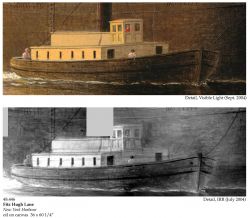

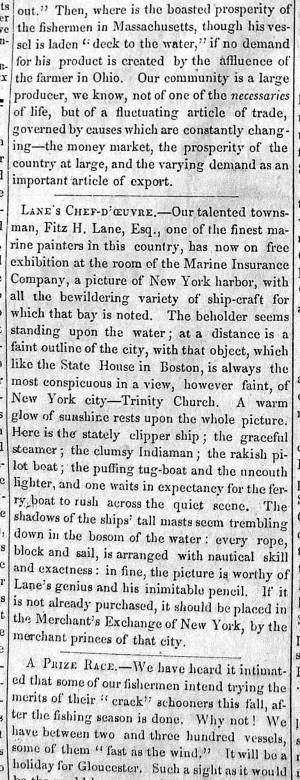

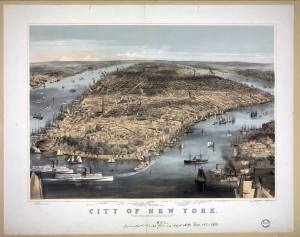
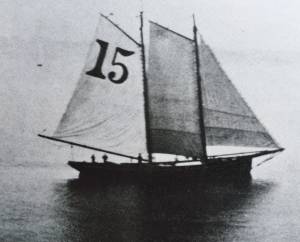
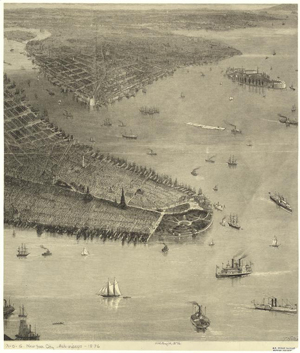
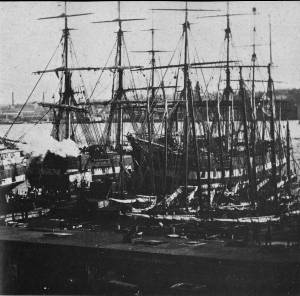

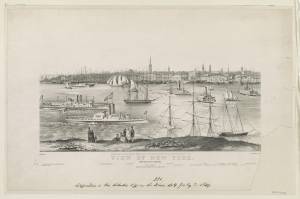
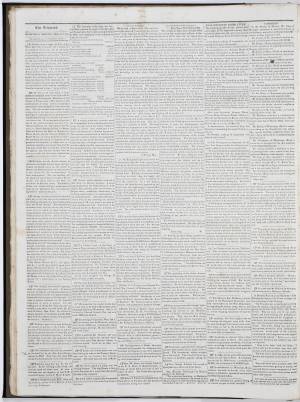
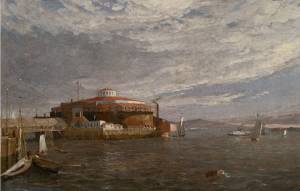
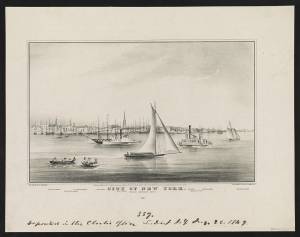

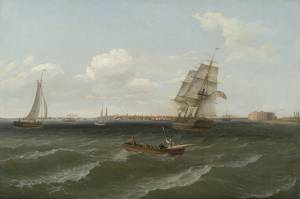
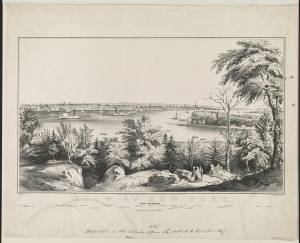
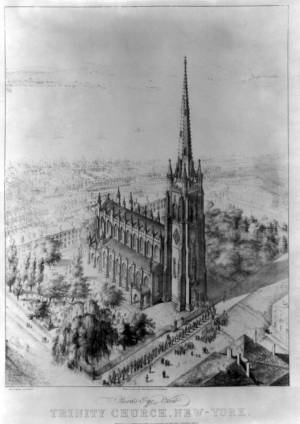
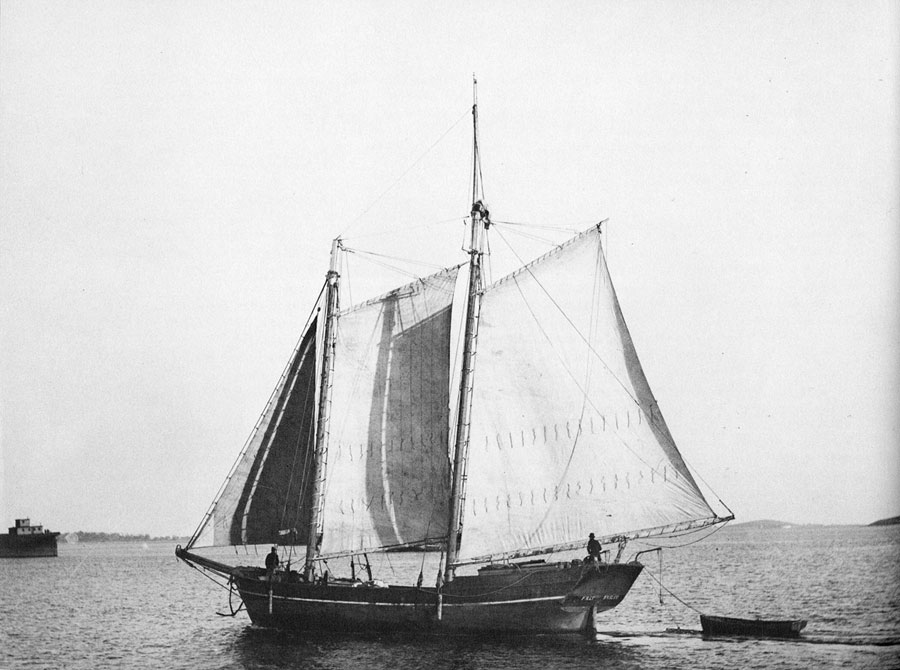
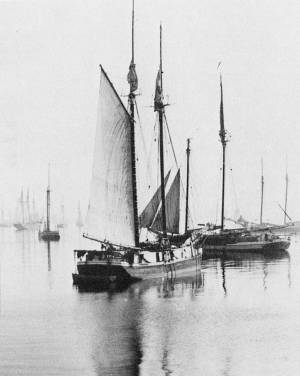


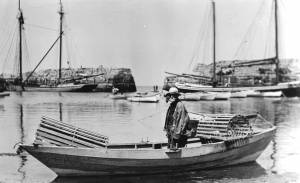

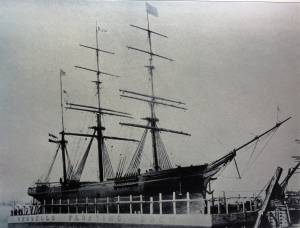
_sm.jpg)

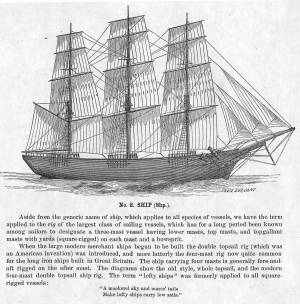
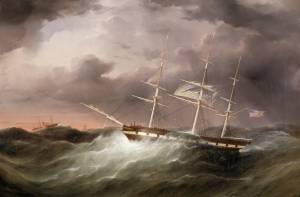





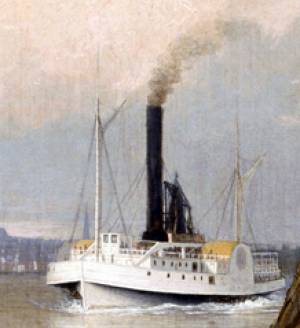

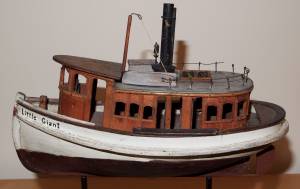

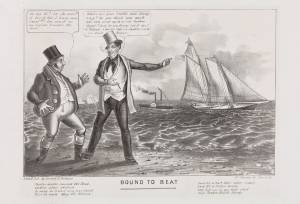

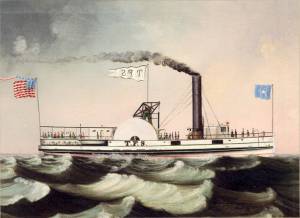

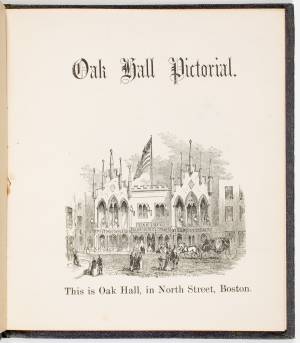
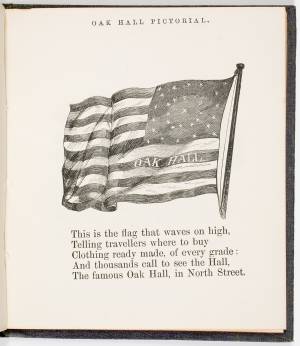
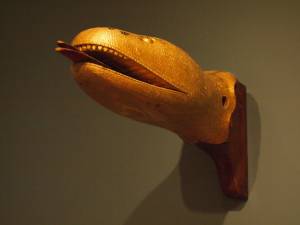
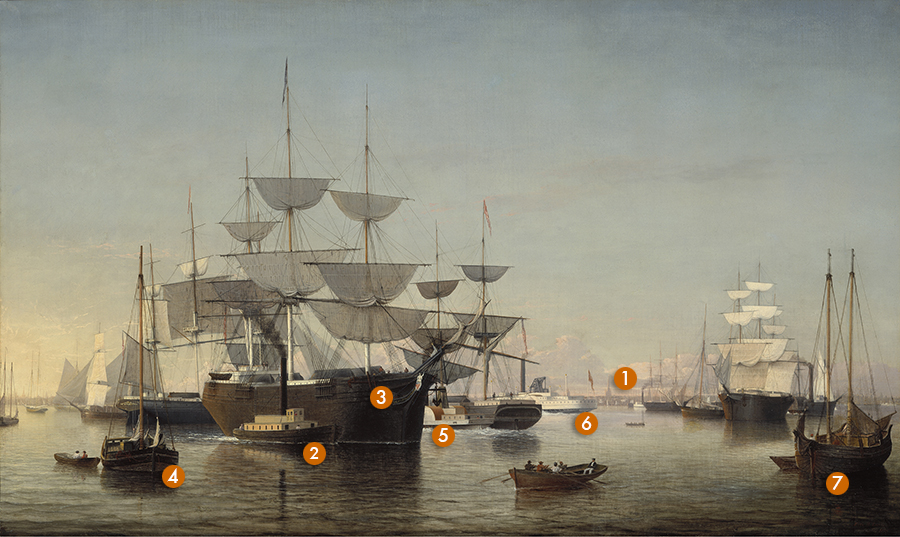
Commentary
New York Harbor at mid-nineteenth century was the undisputed hub of American shipping. New York merchants dominated marine transportation to foreign countries, to other American ports—both Atlantic and Pacific—and to the interior of the continent via the Hudson River and numerous canal systems. Only Boston offered significant rivalry in some aspects of coastal and deep-water trade. (1) Lane’s depiction of New York Harbor has much in common with his Boston views, giving pride of place to vessel activity with just enough of the city skyline visible to make the location identifiable.
To achieve the view seen in New York Harbor, Lane would have been on the west shore of the Hudson, looking due east from a pier in Jersey City. The largely hidden background probably includes Manhattan’s then-northern end at Christopher Street, extending south beyond the Battery, though not as far as Governors Island. The congestion of vessels at wharfside clears to reveal the steeple of Trinity Church against the sky, not unlike Boston’s State House in Lane’s depictions of that city. (2)
On this large canvas (3 x 5 feet), we see the meeting of two technologies for vessel propulsion: sail and steam engine. The former has reached the zenith of its employment; the latter has just begun to prove itself reliable and economical. At center foreground, a harbor tug, using steam to turn its propeller, guides a large packet ship into New York Bay on its way to a transatlantic voyage. Since it rides high in the water, the packet probably has a cargo of cotton stuffed into its hold; no amount of ballast can counter cotton's buoyancy. Partially hidden by the packet ship, a packet brig in the coastal trade is being brought to a wharf by a side-wheel tug (now obsolete). (3)
Beyond the packet brig, a large coastal passenger steamer arrives with travelers and cargo from Long Island or Connecticut, or with similar fare from the Chesapeake Bay and Delaware Bay regions. Scattered about the background are schooners, a half brig, a bark, several ships, and other types of coastal steamers. (4)
In contrast, the foreground shows smaller vessels of local interest, including a Hudson River sloop (left), a Whitehall boat (center), and a very small coasting schooner (right). The sloop is representative of the sailing packets that carried goods and passengers on the Hudson from Albany to New York Bay and—wind and tides permitting—Long Island Sound. The Whitehall boat, named for a street on Manhattan where the first examples were built, was the harbor’s water taxi, transporting people, communications, and small goods between wharves and vessels. Small coasting vessels were used for carrying cheaper goods in smaller quantities over short distances when it was not economical for larger coasting vessels to do the job. (5)
The complexity of vessel activity in this picture is wisely offset by muted atmospheric effects. It is late afternoon with the sun low in the west and fair-weather clouds moving off to the eastward. Sails, flags, and pennants hang slack in the still air; the only vessels moving are under steam power or oars. Has Lane mixed some prophecy into his composition?
– Erik Ronnberg
References:
1. Robert G. Albion, The Rise of New York Port, 1815–1860 (New York: Charles Scribner’s Sons, 1939), 1–15, 373–86.
2. Erik A.R. Ronnberg, Jr., ”A Few Words about this Picture: An 1852 Artist’s View of New York Harbor,” American Heritage of Invention & Technology (Fall 1988): 14-20; and R. Frederick Allen, ed., Inventing America (New York: American Heritage, Forbes, 1995), 34–40.
3. Howard I. Chapelle, "Albion, Rise of New York Port", The History of American Sailing Ships (New York: W.W.Norton, 1935), 97, 116 (cotton trade); 162–64 (steam ships); 277–80 (packet ships); 293–94, 306 (brigs).
4. Ibid., 162–64.
5. Ibid., 303–04 (sloops), 305–06 (schooners); and Howard I. Chapelle, American Small Sailing Craft (New York: W.W. Norton, 1951), 195–99 (Whitehall boats).
[+] See More